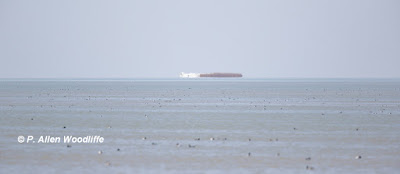But where bits of loose ice remains, it can be a good place to watch gulls. One day not long ago I came across a frenzy of gulls on some loose pack ice at Mitchell's Bay. There were, as usual, a few immature Herring Gulls feeding on fish that were dead and lying on the ice.
And then an adult would come in and challenge the youngster.
But then the fish feast might not have been so appealing.....
.....and hence decided to express its real thoughts.
Still on the gull theme, I had heard that both an adult and immature Little Gull had been seen in the last few days, on Rondeau Bay and at the Keith McLean Conservation Lands. I made an effort to find them there, but was unsuccessful. However when I was checking the Erieau Rail Trail a couple of days ago, there were several Bonapartes Gulls flying along the edge of the bay/marsh area, and then an adult Little Gull appeared. It wasn't very close, so these photos are greatly cropped. The mostly gray upper wing and the darker underwing are characteristic, although before long, the underwing will be quite a bit darker.
Also along the Rail Trail were a few Ring-necked Ducks, which seem to be quite plentiful in many marshes and adjacent areas these days.
Horned Grebes are starting to appear. I saw several at Erieau, and one was close by in one of the boat slips, affording some decent photo ops. This individual has a long way to go before it is in full breeding plumage, which is usually the case this early in the season. I always am intrigued by the bright red eye.
This past Monday I got my first butterfly of the season, an Eastern Comma, but it was flitting steadily and never gave any photo ops. I also heard my first of the season Spring Peepers. It won't be long now until Wood and Chorus Frogs will be in full vocal mode in the sloughs of Rondeau. Certainly things like House Finches are singing loudly. There seems to be lots of them around right now, as evidenced by their vocalizations.
Today I went out to check a few places in the former Dover Township. There were lots of ducks at SCNWA, including the aforementioned Ring-necks and Shovelers. But I didn't see anything new so kept on going. Right across from the NWA headquarters were three Sandhill Cranes in the field. The sun was high and warm, so there was a lot of heat haze to contend with and all the other photos were deleted.
Just around the corner from SCNWA, along Rivard Line, was an ongoing Snowy Owl. I had 5 Snowies in the area a bit north of here just a few days ago, but only two today.
At the Mitchell's Bay South Nature Trail, there was the usual mix of ducks. I also got three Pied-billed Grebes. Two were hooting in the thicker part of the marsh, and the third was furtively hanging out in one of the slips along the trail, but was camera shy. So I took a photo of one of the pair of Groundhogs that were frolicking along the edge of the trail.
The canal along the trail has been warming up, as evidenced by the half a dozen Midland Painted Turtles I saw basking in several places. I also had a large frog plop into the canal, probably a Bullfrog.
At the Bear Creek Unit of SCNWA, I had my first Tree Swallows, but they were constantly swooping over the water in the canal and I did not get any photos.
On the way back I stopped at the Mitchell's Bay North Nature Trail. All of the Phragmites that was killed off last year had been burned, so there was no vegetation to speak of on the berms, and the various canals did not have any birds in them. But just east of the nature trail in a private pond/marsh was something white. A closer look and it turned out to be a Great Egret, my first of the year.
There was a lot of cattail vegetation in the way and I couldn't get very close, so I managed to get around to the road side for a better look. It was much better! There has been the occasional one reported on the Michigan side of the lake already this season, but according to eBird, this one is the first one in Ontario.






















































